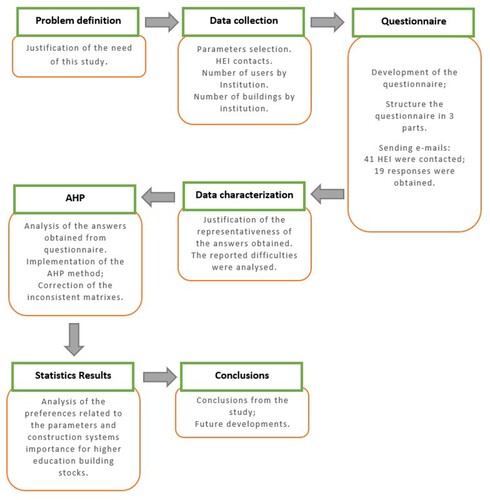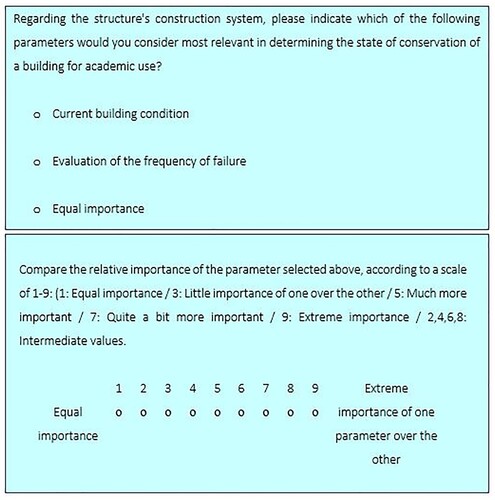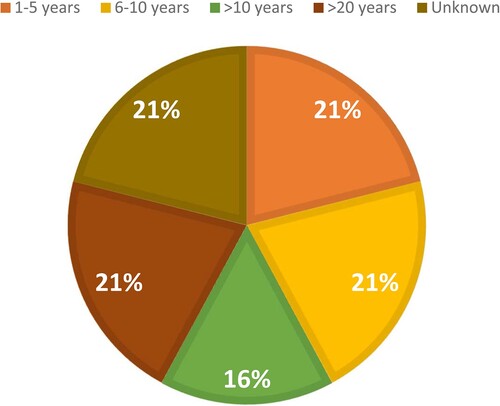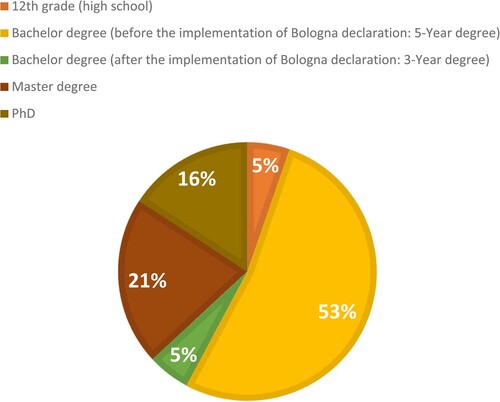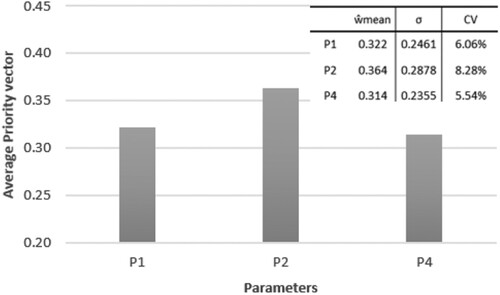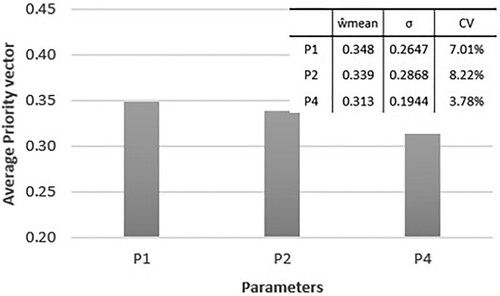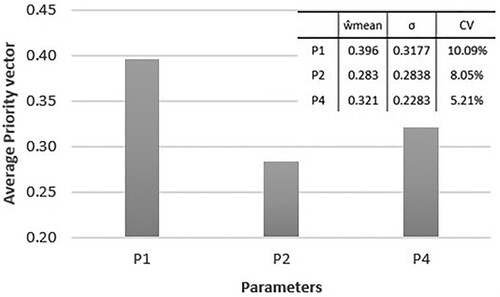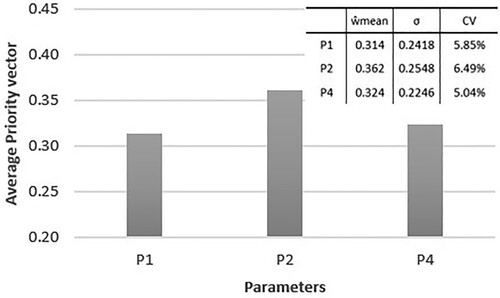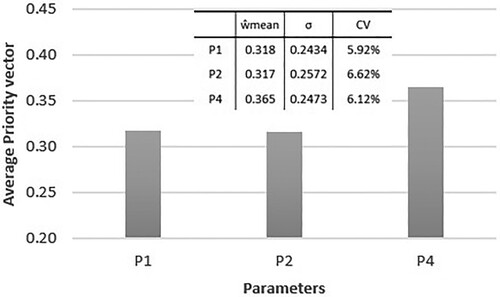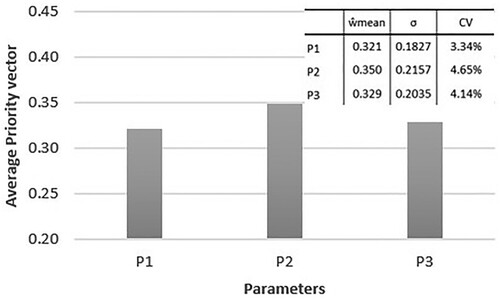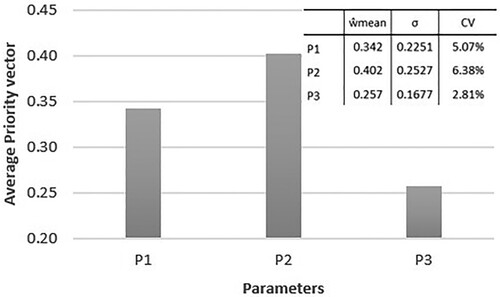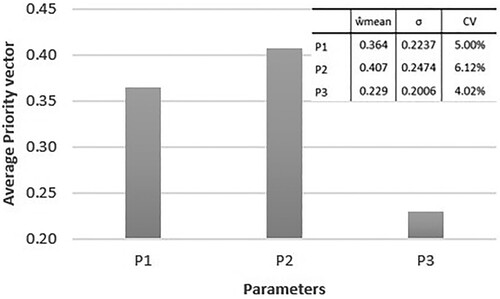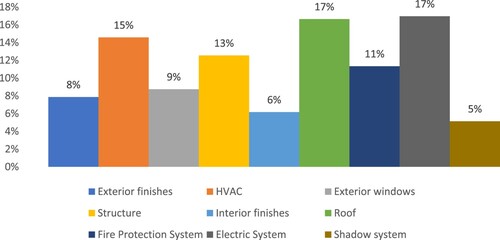 ?Mathematical formulae have been encoded as MathML and are displayed in this HTML version using MathJax in order to improve their display. Uncheck the box to turn MathJax off. This feature requires Javascript. Click on a formula to zoom.
?Mathematical formulae have been encoded as MathML and are displayed in this HTML version using MathJax in order to improve their display. Uncheck the box to turn MathJax off. This feature requires Javascript. Click on a formula to zoom.ABSTRACT
This study aims to provide an overview of the building condition assessment at the facility management stage in higher education buildings in Portugal. A questionnaire survey containing 188 questions was developed and was responded to by experts in the facility management departments of 19 higher education institutions (HEIs) in Portugal. The data analysis, using analytic hierarchy process, showed the difficulties related to the process of facility management and building condition assessment and the experts’ preferences in building condition assessment and facility management in Portuguese HEIs. Four building condition assessment parameters were also evaluated. Although not representative of all HEIs in Portugal, the findings indicate that there needs to be a significant change in the management of the HEI building stock with the support of new digital technologies and the prioritization of preventive actions. This unique view of facility management in Portugal provides useful pointers for facility managers working in HEI in other (European) countries and has relevance to other building typologies.
Introduction
When facing ongoing pressure to reduce operating costs owners and asset managers may tend to look for savings without caring about the long-term consequences. This dynamic makes facility management (FM) a particular target. Moreover, a reactive maintenance approach is observed either in the management of a new public building construction project or an existing building stock. Khalid et al. (Citation2019) revealed that a reactive maintenance management policy is a challenge to be faced in public building maintenance management. The combination of design faults and ineffective building maintenance procedures has brought hazardous and catastrophic consequences to several government buildings. Thus, the integration of a proactive maintenance policy should be the highest priority for the maintenance of existing buildings and new ones too. Since the European building stock is off-track to reach carbon neutrality by 2050, renovation strategies are essential to provide opportunities to companies and facility managers to explore the commitment of FM and rehabilitation interventions with services to streamline management and improve energy performance (BPIE, Citation2014).
In Portugal, the buildings of higher education institutions (HEIs) are typically governed by a reactive maintenance strategy. Many of the buildings in the HEI building stock present several problems. One of the reasons why this has happened is the management based on outsourcing services. Outsourcing aims to reduce costs and increase quality (Tavares, Citation2009). However, the increasing use of outsourcing services often leads to the reduction of quantity and quality of the services, implying that the institution has lower control over the delivery of maintenance management actions and the state of the building stock (Ferraz, Citation2009). Another reason is the lack of historical data about the building stock. The data relating to several buildings, like design plans and other details, were lost, and some buildings have copyrights by architects who do not want to disclose the information. In addition, the current FM strategy appears to be inefficient. The maintenance actions and their costs are not organized by building, being grouped in a set that does not allow having individual or building-specific data. Additionally, the monitoring of energy, water and material consumption is also difficult to access. There are also difficulties associated with public policies and human resources, as well as internal processes involving the management of the building stock. Therefore, this research aims to provide a perspective of the facility managers about FM and building condition assessment (BCA) in HEI, as well as to evaluate parameters to include in a quantitative tool to be employed in BCA and FM practices.
The lack of knowledge about the status of facility management in Portuguese public buildings often prevents public and private institutions from monitoring the progress of maintenance and building management methodologies and processes. There is a lack of data about the facility management procedures, difficulties and needs of the FM practitioners, pronounced by the lack of literature on the subject. The outcome of this work will provide tools to HEI management using a more efficient BCA and FM strategy.
Overview of facility management – challenges, solutions and trends
Facility managers need accurate information to succeed, and with their knowledge and expertise facility managers can solve challenges today and be prepared to prevent future issues (IFMA, Citation2022). The International Facility Management Association (IFMA) in the USA revealed that the lack of staff and finding qualified employees are the biggest concerns of the professionals in the sector (IFMA, Citation2022). Achieving sustainability in the sector is also a concern. Adopting practices to achieve carbon neutrality in the built environment, achieve a smart use of water, energy and materials, aligning those practices with the principles of fair trade and adopting regulations and processes in the operation of the organization are also challenges that meet the environmental, social and governance (ESG) investments. Also, in 2022 companies from the USA (IFMA, Citation2022), Brazil (Junior & Freitas, Citation2022), Spain (Governo do Reino de Espanha & Governo da República Portuguesa, Citation2020), Portugal (República Portuguesa, Citation2020) and UK (UK Environmental Audit Committee, Citation2022) admitted being worried about the environmental impact in the built environment, and cost control of FM practices, as well as an understanding of the user’s needs to adapt the facilities to address their demands along with the challenges mentioned (Infraspeak, Citation2022).
In response to all those challenges, technology is mentioned as the solution and the future trend to serve and enhance FM practice (Infraspeak, Citation2022). Big data and data management, as well as artificial intelligence (AI), are technologies allowing digitalized data to proceed to smart building management. The Internet of Things (IoT) uses sensors and network connectivity enabling all devices and objects to exchange data and effectively communicate with each other to prevent potential faults and breakdowns. Also, augmented reality allied to IoT can enhance remote maintenance work using digital twins (IFMA, Citation2022; Oyarhossein, Citation2021). Automation and robotics with AI, machine learning and IoT are also mentioned since they can change FM practices; mainly because of the multitask automation on FM. However, the FM sector has always had challenges related to maintenance backlogs, ageing infrastructure, rapidly emerging technologies, achieving sustainable goals and ensuring a skilled future workforce (IFMA, Citation2022).
Academic building stock – overview and challenges
The building stock in HEIs is extensive, composed of buildings with multiple specifications, which include several materials and systems and access to data is often not possible. Furthermore, publicly available reports of the building maintenance management and past interventions are not available. Beyond that, there is a lack of statistics related to the building stock of higher education, as well as FM tasks, challenges and difficulties. However, decision-making depends on the practitioners, and it can have consequences on durability and building life span, built environment and user’s safety and comfort. That is why transparent decision-making must be based on statistical data and relevant information.
The National Statistical Institute (The Instituto Nacional de Estatística I.P. INE in Portuguese) is the central body for the production and dissemination of official statistics in Portugal. As for construction and housing, INE provides statistical results related to the housing regular maintenance and repair prices index and production factor (INE, Citation2018, Citation2020). However, it does not present any information about the maintenance of HEI buildings. PORDATA is another database that presents statistics and aims to collect, organize, systematize and disseminate information on multiple areas of society for Portugal, municipalities and European countries. The statistics come from official and certified sources, with information production competencies in the respective areas. However, this website does not include information about public building stocks, like HEI. It is also focused on housing statistics, house life conditions and buildings by their age of construction, type and price (PORDATA, Citation2021).
Hauashdh et al. (Citation2021) have highlighted some challenges to be faced during the practice of maintenance works, pronounced by the lack of information, related to the lack of accessibility of building components, which can be a safety risk even for future repair works and the lack of maintenance planning during the design stage. Also, the lack of training and technical resources in terms of communication technology and the limited human resources lead to inefficient repair and minimization of user satisfaction in the building. As informed and transparent decision-making must be based on statistics, data related to tasks included in FM are essential to proceed with clarified decision-making that can determine the success or failure of buildings. These data allow the development of the procedures of the FM and BCA to enhance existing building FM practices towards their successful implementation.
Due to the lack of data related to FM of the academic building stock, a questionnaire was developed and issued to the various national HEI’s in Portugal. The research objectives were to (1) collect data about the main difficulties facing facility managers of HEI and (2) use the analytic hierarchy process (AHP) to provide a set of preferences related to the quantitative measurements that should be carried out during BCA, as well as their relative importance. The originality of this work consists of having decision-making support based on the experts’ opinions related to BCA and FM of Portuguese HEIs.
Methods
Research by Shohet (Citation2003) was fundamental to the development of this research. Shohet evaluated the parameters of ten building systems for hospital buildings, and this was used as inspiration for the current research. However, this research incorporated a new parameter in addition to the one considered by Shohet (Citation2003): the degradation evolution, which replaced the frequency of failures for some construction systems.
A questionnaire survey was designed and issued to individuals in charge of facility management departments in 41 academic institutions in Portugal. The methodology adopted is represented in . The number of users by each institution and the number of buildings belonging to each institution are shown in . The questionnaire was composed of three facility management professionals skilled in academic knowledge and with tactical and strategic experience. Facility managers in charge of the University of Aveiro building stock also helped in the development of the questions to ensure that there was no ambiguity. The questionnaire was developed using Google forms (Google, Citation2023) with a total of 188 questions, and was issued via direct contact with FM experts working in 41 HEIs. This resulted in 19 completed questionnaires. The respondents’ answers were subject to statistical analysis, and the representativity of the answers was calculated to justify how 19 answers can be representative of the whole Portuguese academic building stock.
Table 1. Number of Portuguese academic institutions by type of education institution and type of education (DGES – Direção Geral do Ensino Superior, Citation2021).
Portuguese academic institutions
The subjective judgment obtained on the multiple-choice responses was translated into preferences according to the AHP method. Using this method, it was possible to understand which parameters BCA should include for each construction system and which is the relative importance of each parameter to be evaluated, as well as, of each construction system to accomplish the building performance of a higher education building. To clarify, a construction system is defined as a system that results from the interaction of construction objects organized to achieve specific purposes (ISO 12006-Citation2: Citation2015).
Problem definition
Matos et al. (Citation2021) applied a key performance indicator (KPI) to evaluate building conditions and tested it in a case study on a higher education building. The KPI included the following parameters: evaluation of the condition, frequency of failure and frequency of preventive maintenance, whose importance was obtained and adapted from (Shohet, Citation2003). This author used, evaluated and validated those parameters for hospital facilities. Therefore, the parameters’ test and evaluation must be studied specifically for each building typology, and there is still a lack of information about them at HEIs, which is the intention of the current research. Even though these parameters were considered as a starting point for the questionnaire, one more parameter was added to the study.
Data collection
BCA is a multidisciplinary survey that involves several fields, in which its practices, difficulties and preferences in the higher education building stock are essential data to be shared and discussed. The questionnaire aimed to understand experts’ preferences about four parameters to be included in the BCA and the difficulties they usually feel in facility management practice. Considering the size of the questionnaire and the complexity of BCA evaluations in large building stocks as a starting point, just four parameters were considered:
Evaluation of the current condition: Reflects the deterioration of each system, in which its state of conservation is evaluated, namely, the system's performance through the appearance of anomalies and their degree of severity that may or may not have implications for the safety and stability of the building.
The frequency of failure: Number of times the anomaly appeared in a year.
The frequency of maintenance actions and inspections carried out: Number of times maintenance actions and building inspections were carried out to a given building system in a year.
Evolution of the anomaly extension: Reflects the extension of the defect. Its quantification can be expressed through the percentage of affectation of the anomaly presented in the facade.
Although Matos et al. (Citation2021) used three parameters in their study, in the current article the evolution of the anomaly was also added, which aims to contrast with the frequency of failures. This contrast makes it possible to understand which construction systems should include the evolution of the degradation as a BCA parameter and which ones should include the frequency of failures, according to the expert’s opinion.
This questionnaire is useful to understand the choice on the evaluation of the degradation by the evolution of failure assessment or by frequency of the failures, for each construction system; understand the respondent’s preferences about the importance of each parameter to be considered in the BCA method; validate the relative importance of the systems for higher education buildings and set conclusions about the difficulties that experts in FM have been facing during their careers. This information allows an overview of BCA preferences and difficulties felt by facility managers on HEI building stocks.
Structure of the questionnaire
The questionnaire consisted of three parts and 188 questions. Part 1 with 10 general questions related to the personal information and 108 questions considered nine construction systems and four BCA parameters (Part 2). The third part of the questionnaire was composed of 70 questions, which measured the importance of each construction system for the intended purpose of the building (Part 3).
Part 1 collected respondents’ personal information, including years of work experience, job level, nature of the organization, type of employer and academic qualification, as well as the type of their work (technical or strategic). This information allowed inter-group comparisons to be made when analysing the survey data. Part 2 solicits the importance ratings of four BCA parameters for each construction system on a nine-point scale. It consists of multiple-choice questions concerning the relative importance of some categories over others. The parameters under evaluation are P1- the building condition; P2 – the frequency of the maintenance activities to maintain the system; P3 - the frequency of failures; P4 – the evolution of the extension of the anomaly.
This makes it possible to conclude for each construction system: the parameter choice for the evaluation of the degradation that will be included in the BCA evaluation; the evolution of failure assessment (P4); or the frequency of the failures (P3). The third part focuses on the importance of each construction system in academic building typologies. This part is important to set priorities according to the use of the space.
An example of the questions is shown in .
To increase the level of representativeness of the samples, FM practitioners with different organization natures (public and private) were invited to participate.
Data characterization
Representativeness of the questionnaire answers
In Portugal, there are a total of 105 HEI, 41 from the public type, as shown in . Considering the sample size equation (Daniel, Citation1988; Naing et al., Citation2022), it is possible to verify that the 19 respondents provide a 90% of confidence level with a 19% error margin, which is acceptable for the objectives established in this research. presents the number of responses by institutions by type of HEI. Some of the institutions are university and polytechnic HEIs, which is the reason why both types are accounted for in those two types of the education system. Private institutions, such as HEI L, have university and polytechnic education.
Table 2. Cumulative number of answers to the questionnaire according to type of institutions and type of education.
The academic institutions’ responses are discriminated in . The number of responses per HEI varied, which is related to the size, structure and organizations of HEIs, that in some cases have different maintenance responsible for each campus or centralized management for all the HEI. Although there are different facility management strategies on the different HEI, the answers did not go into this detail, however, can be comparable at least by the different HEI’s dimensions.
Table 3. Number of answers to the questionnaire by type of HEI.
The representativeness of the study was calculated by means of the number of users of each institution (students, professors and researchers and administrative staff) as presented in .
Figure 3. The number of responses, users and buildings by each HEI that participate in the questionnaire.
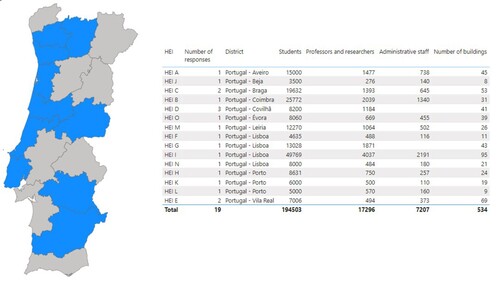
Information about the national number of students, professors, researchers and administrative staff of HEI was searched and gathered in . The comparison between the numbers gathered in and the total number of students and professors can support the representativity of the questionnaire, because (1), the facility managers have different experiences based on the HEI they are representing and (2) their experiences are influenced by the number of buildings they have to manage and by the number of users of those buildings.
Table 4. Representativeness of the study based on the number of students included in each HEI that respond to the questionnaire.
makes it possible to verify the answers from the questionnaire have a representativeness of 47% when considering the total of students of the HEI in Portugal. Despite getting just 19 answers, this representativeness can be justified by the number of users from the HEI I, HEI B, HEI C and HEI A, which are important samples to get a high level of representativeness since they have a high number of users and large building stocks.
Characterization of the respondents
Respondents (the statistical units) were characterized by their years of experience in facility management (), type of experience (in the worksite or the office) () and academic qualifications of each respondent ().
Most of the responses were given by people holding a degree before the implementation of the Bologna declaration (5-year graduation), as presented in .
Reported difficulties
It was possible to establish several challenges experienced by respondents during facility management, building inspections and defect diagnosis of the academic building stock.
The challenge most highlighted by respondents was the lack of qualified technical human resources, forcing heavy dependence on outsourcing with high response times for first-line maintenance. This point matches the challenges reported by the members of the International Facility Management Association (IFMA, Citation2022). This is followed by insufficient funds for maintenance, human resources and equipment, which are dependent on public politics and internal processes, forcing the institutions to use outsourcing on a reactive management basis. The solutions are based on ‘patching up’ the problems/anomalies that deserve more attention to be solved to avoid reoccurrences. However, in some cases, there are also impediments from internal politics/administration to the contracting of the suppliers considered most suitable for the maintenance actions. The respondents also reported that there are too many unpredictable tasks due to the lack of a predictive and preventive maintenance policy because there is a lack of human and technical means to comply with daily planning and requests. For some institutions, the decision-making centred on a preventive maintenance strategy as a cost-saving measure rather than an investment.
The large scale and complexity of existing structures and equipment is a reality of HEI building stocks and a difficulty for facility managers. The lack of specific equipment to do the building assessment causes inadequate and poor prioritization of the interventions and the preventive maintenance strategies, causing the building condition to worsen.
Another challenge reported was the lack of as-built drawings and registers of changes to the buildings. Building information is lost over the years and no databases exist where the information related to the buildings is stored. Furthermore, the maintenance actions undertaken during the building life cycle are disrupted, which makes the task of FM difficult, causing decisions and planning of maintenance actions; resulting in errors and omissions that need to be solved later during the work and which lead to increased costs.
The facility managers also highlighted the lack of databases of ratios of maintenance costs/m2 of gross floor area, which leads to errors and extra costs that do not match the planned maintenance actions. The lack of specific legal requirements for maintenance, statistics, databases and guidelines for building maintenance is also a factor that adds to the challenge of providing adequate maintenance management for an ageing building stock. Allied with that, the lack of resources to address urgent and recurring anomalies lead to a snowballing and catastrophic situation. Furthermore, the facility managers are struggling to manage the unforeseen building anomalies with the normal use of the building and outdoor spaces because some maintenance works imply shutting down the technical systems (telecommunications, water and energy). It was also claimed that many defects and anomalies that arise during the building life cycle are the faults of the lack of concern in the design of buildings (initial construction) for their maintenance. However, the long service life of buildings (building stock over 50 years old), in which is spent many resources and money (which is often not available), justifies the initial investment in maintenance management.
Respondents also reported difficulties during building condition assessments. Their concerns related to the complex and large-scale structures with a lack of historical data because the final as-built documents as well as the organized records of maintenance interventions do not exist. Space accessibility was also pointed out, making it hard to locate technical installations and to carry out a full diagnosis. This is related to diagnosis in hidden installations or involving work at height, where it is hard to gauge the origin of problem, such as electric network failures. Additionally, the lack of awareness of maintenance activities previously performed leads to planning solutions that later turn out to be inappropriate, and result in extra costs and work. The lack of human resources and equipment was also reported as problematic since the lack of know-how in specific maintenance activities leads institutions to outsource. The difficulties related to the slowness of public contracting and the lack of skilled internal technicians exacerbate the building condition. This information is supported by previous research (discussed earlier).
Based on the difficulties reported, future research work intends to respond to these concerns by making a BIM-based platform to record all the anomalies and interventions performed in the building during its building life cycle. This task will be supported by employing a modified building condition indicator that includes the evaluation of building condition, the frequency of failure/ the evolution of the extension of failures and the frequency of preventive maintenance actions.
The relative importance of the parameters to include in BCA
A first evaluation was conducted to understand the preference of the respondents between the frequency of failure and the evolution of the extension of failures for each system. The preference between these two parameters was analysed individually for each building system, and the parameter considered most relevant was obtained through the highest percentage of preference by the respondents. It was found that for construction systems (structure, exterior and interior finishes, windows, roof, shadow systems) it was more important to evaluate the evolution of the failure than the frequency of failure. For equipment (electrical system, HVAC and fire security system) it is the opposite, see .
Table 5. Parameters to be considered in BCA for each construction system.
Being aware of the expert’s preferences related to the parameter to the failure assessment for each construction system, the three parameters evaluated by experts for BCA could be analysed using the AHP method.
Description of the analytic hierarchy process (AHP)
Subjective judgment in BCA
Evaluation by its nature implies the use of the personal judgment of qualified experts because experts must ultimately take professional responsibility for the evaluation, so the requirements for evaluation cannot be standardized (ASCE, Citation2014). Therefore, sharing experiences, practices and difficulties is essential to progress in building evaluation, which is so dependent on the experts’ judgment. The subjective and qualitative answers to the questionnaire were transformed into a numerical rank that indicated the order of preference among them using AHP. The condition rating that follows the building assessment is used to objectively determine the current condition of the building. A rating system that minimizes subjective evaluation is repeatable and can be effectively used to predict the building’s future condition (Yacob et al., Citation2016).
The hierarchic structure of the AHP method
Pairwise comparisons are commonly used in multicriteria decision-making methods for prioritizing alternatives. For prioritizing alternatives in decision-making problems, Saaty (Saaty, Citation1977, Citation1980, Citation1987) proposed a mathematical technique named analytical hierarchy process (AHP), in which a pairwise comparison matrix A is built to easily process relative comparisons data. It allows the experts to evaluate the attribute weightings with greater consistency through pairwise comparisons and relies on the judgements of experts to derive priority scales. In AHP, all criteria or parameters are assigned a weighted score that shows the importance of each criterion. The AHP approach has been widely adopted in the built environment fields as a decision-making tool (Saaty, Citation1987).
The AHP was developed to model unstructured problems in which it is necessary to decide without having an exact notion of the importance of the parameters used.
The preferences of the decision-makers are given through subjective judgments of the participants, making them quantify their judgments according to the relative importance of the factors under analysis (Briozo & Musetti, Citation2015). The relative importance (relative weight) of each parameter within each construction system was established using a square matrix structure. For each parameter, the weight was calculated by the geometric mean of values of questionnaire responses. In using the AHP for prioritizing alternatives in a decision-making problem, it is advised a hierarchic structure to represent the alternatives of the problem under study. The hierarchic structure of the problem definition is represented in . The hierarchic structure of the decision-making.
AHP Model structure
In terms of failure assessment, is parameter P4 – the evolution of the anomaly extension more important than parameter P3 – frequency of failures? Which parameter should be included in the BCA evaluation?
Which parameter (P1, P2, P3, P4) is considered more important for each construction system?
The survey asked respondents to compare the relative importance of the parameters on a scale from 1 to 9, according to the fundamental scale defined by AHP (Saaty, Citation1977). The objective of using the AHP is to generate a pairwise comparison matrix A = of order n, where n is the number of parameters (i, j = 1, … , n) from which the parameters can be arranged hierarchically in terms of importance for the definition of the weights. The matrix is positive and reciprocal, which means the value of importance assigned to one parameter i, when compared with parameter j, is the reciprocal value assigned to j when compared with i (i.e.
= 1/
). The number of judgments required is n(n − 1)/2.
Definition of the weights and correction of inconsistency
In mathematical methods and techniques for decision-making using the pairwise comparison matrix A, a vector giving the priorities for the different alternatives is defined and from it, a transitive pairwise comparison matrix, free from inconsistencies, can be constructed. Saaty (Citation2003) proposed that the vector of priorities of the alternatives is the right eigenvector of the matrix A. The AHP allows for identifying the value of the weights based on judgments. This process calculates the weights by using the eigenvector associated with the maximum eigenvalue of matrix A (Saaty, Citation1977). The eigenvector calculation is the most appropriate method to synthesize the set of pairwise comparisons and obtain a vector of relative weights because it makes use of all the dominance information given in the matrix when it is not consistent (Heras, Citation2018). However, according to Saaty (Citation1987), it is also possible to get an approximation of the priorities by normalizing the geometric means of the rows, for n ≤ 3. Some authors have been adopting this straightforward alternative to solve several kinds of judgment problems (Costa, Citation2015; Crawford, Citation1987; Khalil et al., Citation2016; UKDCLG, Citation2009). As an example, presents one complete matrix of pairwise comparisons obtained from one of the respondents of the survey.
Table 6. Matrix A of the HVAC, composed of a set of pairwise comparisons from one of the respondents of the questionnaire.
The parameters under evaluation for HVAC are P1, P2 and P3 are the under evaluation, which correspond to P1 – Building condition, P2- Frequency of preventive maintenance and P3 – Frequency of failures. The numerical ranking of the alternatives/parameters that establishes the order of preferences among the alternatives is obtained from this matrix using the priority vector (Saaty, Citation2003). In the current research, the priority vector was obtained by normalizing the geometric means of the rows of each Matrix. This procedure was followed for all answers to the survey, calculating the vector of relative weights for each answer.
The consistency of the vector was checked following the proposed approach by Harker (Citation1987). Some answers resulted in inconsistent matrices. Having a consistent matrix does not mean that the answer is correct or closer to the ‘real’ life solutions. However, having a consistent matrix means that the answers are closer to being logically related than being randomly chosen. That is why a method for correcting the consistencies developed by Saaty (Citation2003) and used by Jarek (Citation2016) was employed. present the results analysis of all the responses for each construction system. They present the median value of the weights obtained by all respondents for each parameter under evaluation, the standard deviation (σ) and the coefficient of variation (CV). It also includes charts where the parameters evaluated are represented by the average priority vector.
Analysis of the results
Analysing the vectors of the preferences obtained by the AHP
The results from AHP implementation are the priority vectors, which translate the preferences and the relative importance of each parameter to evaluate the BCA for each construction system. The results obtained provide valuable data about preferences of the experts on three parameters to integrate into a Building Condition Indicator in the future. This indicator is essential to perform an efficient BCA strategy and will support digital tools to enhance FM. However, the statistical information conveyed by several experts from the various Portuguese HEI needs to be disseminated first so that other participants in the sector can be aware of the difficulties experienced to develop practices that improve the FM of HEI. The results of the questionnaire analysis are presented below.
presents a summary of the priority vectors for each construction System. present the priority vectors for each construction system (mean) graphically, as well as their respective standard deviation (σ) and covariance (CV).
Table 7. Summary of the priority vector for each system.
present the relative importance of each parameter to evaluate BCA for each system, using the experts’ answers to the questionnaire. However, due to the reason presented above, present the construction systems being evaluated by the parameters P1, P2 and P4 and present the equipment being evaluated by the parameters P1, P2 and P3.
For structure (), the frequency of preventive maintenance (P2) is the most important parameter and its evaluation should be weighted as 36.4% of the BCA. The evaluation of building condition (P1) takes the second place of importance on the structure assessment being this kind of evaluation is 32.2% of BCA. The evolution of the degradation (P4) takes the last place of importance for structure and windows systems, having respectively 31.4% and 28.3% of the influence on BCA.
The evaluation of the physical condition (P1) is considered the parameter with more importance in BCA for exterior finishes (), interior finishes () and windows (). For exterior finishes (), the frequency of preventive maintenance (P2) takes the second place of importance, which contributes to 33.9% of BCA evaluation. The evolution of the degradation (P4) should be considered with 31.3% of importance in this evaluation.
As for interior finishes (), the evolution of degradation (P4) should be included in the BCA evaluation with a 32.1% of importance and the frequency of preventive maintenance actions (P2) should be considered with a 28.3% of importance.
As for the roof system (), the frequency of preventive maintenance actions (P2) should be included in the BCA evaluation with a 36.2% of importance and the evolution of degradation (P4) should be considered with a 32.4% of importance in BCA, being the condition of the system (P1) the less important on the roof evaluation. The shadow system () evaluation should consider 36.5% of importance to the evaluation of the evolution of the degradation of the system (P4), 31.8% of importance to the evaluation of the physical condition of the system (P1) and 31.7% of importance to the evaluation of the frequency of preventive maintenance actions (P2).
For the equipment, such as the electrical systems (), HVAC () and fire security systems (), the most important parameter to be considered in the BCA evaluation is the frequency of preventive maintenance actions (P2), which assumes 35%, 40.2% and 40.7% of importance to these systems respectively. For the electrical system (), the frequency of failure (P3) takes second place of importance, representing 32.9% and then the evaluation of physical condition (P1) with 32.1% of importance.
As for HVAC () and fire security systems (), the evaluation of the physical condition (P1) has 34.2% and 36.4% of importance respectively, followed by the frequency of failures (P3) of the system with 25.7% and 22.9% of importance, respectively.
Discussion
A comparison of the results with a benchmark is not possible because there are no similar studies related to HEIs. However, considering the above characteristics, it is possible to understand and highlight the novelty that the present work can give to the scientific community in the field of Portuguese FM-HEI. However, some comparisons between the two studies can still be established. According to Shohet (Citation2003), the relative importance of the building condition and frequency of failures is higher than the preventive maintenance parameter for most construction systems (except for the systems vital to the comfort and survival of the customers, such as medical gases systems), which can also be observed in the current work. For instance, in the case of the structure, the physical performance and the frequency of failures are the highest, which reflects the low input on preventive maintenance in the structural elements. However, the economic distribution to the different parameters may not be the most appropriate since preventive maintenance plan is not always accomplished, which reflects the investment made. So, the current study enables establishing the parallelism between the parameters’ importance by means of their respective input investment and the opinions of the various experts. However, this comparison must be made for the same type of buildings.
This study allows the calculation of the BCA based on the relative importance of each parameter to be evaluated according to a scale. It was also verified that the experts with more experience in the field of facility management gave more importance to the parameter of frequency of preventive maintenance and building conditions of the systems.
The high standard deviation and variance are caused by the discrepancy of the opinions about FM and BCA among the experts, which is highly related to their experiences and the type of work carried out. This is a complex problem that is related to the type of maintenance applied by each HEI. People’s feelings and preferences remain inconsistent and intransitive. Although an inconsistency can be considered to be a positive characteristic, forced consistency without knowledge of the precise values is undesirable (Saaty, Citation1977, Citation2003). The judgments of people are based on their thoughts, feelings and preferences, so there is no sense to keep insisting on consistency. and present the relative weights of each parameter under study for each construction system.
Table 8. Distribution of internal weights (%) of construction building systems.
Table 9. Distribution of internal weights (%) of building equipment.
The weight of each parameter (presented in and ) provides the relative importance of each type of evaluation in BCA. The evaluation of all building systems must be adequate since their performance are dependent on different requirements. That is the reason behind the importance of the relative importance of each parameter to evaluate their state, individually. Each parameter and its importance provide the opportunity of representing each system under evaluation, which also gives the operational perspective, as it will be further approached.
Relative importance of the systems
Each construction system has different importance for the general building performance, which usually can be measured by life cycle costs (LCC). The contribution of the components is determined by the economic value of the periodical inspections versus the value of preventive maintenance and repair activities. When that is not possible, the relative importance of the system for performing the function for which the building was designed must be set according to the experts’ opinions. So, in this case, for higher education buildings, the relative importance of each construction system was set by employing the questionnaire, which answers were also analysed by the AHP method and the values are summarized in .
It was possible to obtain the relative importance of the building systems to accomplish the building function with a level of performance equal to or higher than the one designed. In this case, the evaluators consider the roof and the electrical system to be the most important for higher education buildings, followed by the HVAC system. The fact is that the roof is not in good condition and will affect all surrounding systems, which can be an expensive investment to repair. The electrical system and the fire protection system are relevant to the building’s performance since they need to be monitored and the service life of the materials must be monitored since the manifestation of their failure can lead to the functional failure of the building and to the occurrence of accidents that carry on human and material losses.
The fourth place of importance is the structure, and then the fire protection system. The system with less importance was considered to be the shading system. The structure system is most of the time not visible, and its maintenance of greater difficulty and reparation is too intrusive. However, since there are defects in buildings due to structural causes, the structure system assumes a great relevance in the overall building performance, once its failure can lead to building failure, and the intervention requires a greater investment. This preference reflects the level of investment that each building system required to be built and to be maintained. The building is the combination of all the components that make up its systems which are all directly related. The more the system is needed to accomplish the correct performance of the building, the more use and maintenance it requires and the more important it will have in the building as a whole.
Conclusion
Effective decision-making and the prediction of degradation processes in academic building stock are only possible when based on a correct understanding of the maintenance management of this type of asset. It is necessary to know the building conditions and be aware of empirical data that enables the understanding of the difficulties that most commonly arise, and hence what should be evaluated in a BCA process. Facility management is a still an undervalued task in the Portuguese HEI sector, which is complex and large in scale, and the buildings are in an advanced state of degradation. The lack of know-how on the part of technicians, poor management on the part of administrative policies and occasional outsourcing aggravate the situation. These were the main issues reported in this research. The research also addressed and presented issues not previously reported, such as the relative importance of construction systems in the HEI building stock. This research allowed the facility managers to disclose their practices and concerns, and in doing so help to enhance the field of FM by providing unique and valuable insights.
The results of the questionnaire provide the opportunity to develop more effective strategies for BCA and building inspections, data records and classification, as well as to prioritize maintenance works, which intend to contribute to a more sustainable built environment. The questionnaire confirmed that the current scenario of public building maintenance is predominantly reactive and building maintenance and building design are treated as two different aspects. The information is dispersed and the several fields included are difficult to coordinate. The questionnaire helped to reveal the main difficulties that HEI FM experts have felt in their careers and their preferences related to BCA. This has significant relevance to decision-making in FM, as well as helping to develop new work methodologies and contribute to a more sustainable built environment.
The limitation of this study was the inability to obtain a response from all HEI professionals in Portugal, thus the results may not be representative of all views and opinions in this sector. However, the results present the first investigation of this type in Portugal. Based on the difficulties reported by the respondents, the future directions of the research should try to respond to those facility manager’s concerns, by the development of a unified platform for sustainable facility management, which includes an optimized method to proceed to BCA, a Prediction Degradation Model, the building digitalization based on Photogrammetry and laser scanning then integrated into the BIM methodology and databases of sustainable buildings’ processes and materials that can be used on the maintenance and refurbishment interventions. As for the limitations of this study, despite the representativeness of this analysis, the research scope is limited to HEI. However, the same approach could be reproduced for other building typologies, such as healthcare and large commercial portfolios regardless of geographical location.
Disclosure statement
No potential conflict of interest was reported by the author(s).
Additional information
Funding
References
- ASCE. (2014). Guideline for condition assessment of the building envelope. In ASCE standard (Issues 30–0). https://doi.org/10.1061/9780784413258
- BPIE. (2014). Renovation strategies of selected EU countries. ISBN: 9789491143113.
- Briozo, R. A., & Musetti, M. A. (2015). Método multicritério de tomada de decisão: Aplicação ao caso da localização espacial de uma Unidade de Pronto Atendimento-UPA 24 h. [In English: Multicriteria method for decision making: Application to the case of spatial location of a 24-hour emergency care unit, Gestão e Produção 22(4), 805–819. https://doi.org/10.1590/0104-530X975-13.
- Costa, M. (2015). O Problema de seleção de fornecedores considerando vários produtos. [In English: The problem of selecting suppliers considering several products.] [Master’s thesis]. University of Aveiro, Aveiro, Portugal. Retrieved 4 April 2023 from https://ria.ua.pt/bitstream/10773/16288/1/O%20problema%20de%20sele%C3%A7%C3%A3o%20de%20fornecedores%20considerando%20v%C3%A1rios%20produtos.pdf
- Crawford, G. B. (1987). The geometric mean procedure for estimating the scale of a judgement matrix. Mathematical Modelling, 9(3–5), 327–334. https://doi.org/10.1016/0270-0255(87)90489-1
- Daniel, W. W. (1988). Biostatistics: A foundation for analysis in the health sciences. Biometrics, 44(1), 317. https://doi.org/10.2307/2531929
- DGES - Direção Geral do Ensino Superior. (2021). Courses and higher education institutions. Retrieved 03 August 2022 from https://www.dges.gov.pt/pt/pesquisa_cursos_instituicoes?plid=372&instituicao=&cursos=&distrito=&tipo_ensino=2&tipo_estabelecimento=2&area=&tipo_curso=
- DGES. (2021). Número de inscritos no ensino superior atinge máximo anual mais elevada da última década. [In English: Number of people enrolled in higher education reaches the highest annual maximum in the last decade. ] In Ministry of Science, Technology and Higher Education. Retrieved 03 August 2022 from https://www.dges.gov.pt/pt/noticia/comunicado-numero-de-inscritos-no-ensino-superior-atinge-maximo-anual-mais-elevada-da-ultima
- Ferraz, D. (2009). O outsourcing na Administração Pública. [In English: Outsourcing in Public Administration.] 0–18. 7° Congresso Nacional da Administração Pública [In English: 7th National Congress of Public Administration], November 2009.
- Google. (2023). Google forms. Retrieved February 08, 2023 from https://www.google.com/forms/about/
- Governo do Reino de Espanha, & Governo da República Portuguesa. (2020). Estratégia comum de desenvolvimento transfronteiriço. [In English: Common cross-border development strategy.] Retrieved February 02, 2023 from https://www.portugal.gov.pt/pt/gc22/comunicacao/comunicado?i=governo-apresenta-estrategia-comum-de-desenvolvimento-transfronteirico
- Harker, P. T. (1987). Incomplete pairwise comparisons in the analytic hierarchy process. Mathematical Modelling, 9(11), 837–848. https://doi.org/10.1016/0270-0255(87)90503-3
- Hauashdh, A., Jailani, J., Rahman, I. A., & AL-fadhali, N. (2021). Structural equation model for assessing factors affecting building maintenance success. Journal of Building Engineering, 44(May), 102680. https://doi.org/10.1016/j.jobe.2021.102680
- Heras, J. (2018). Reduction of the seismic vulnerability of vernacular architecture with traditional strengthening solutions [Doctoral dissertation]. University of Minho, Portugal. Retrieved 4 April 2023 from https://hdl.handle.net/1822/58336
- IFMA. (2022). FMJ – International Facility Management Association (IFMA). Facility Management Journal. Retrieved 29 September 2022 from fmj.ifma.org/publication/?m=30261&i=759592&p=1&ver=html5
- INE. (2018). Housing regular maintenance and repair prices index (p. 2018). Retrieved 3 August 2022 from https://www.ine.pt/xportal/xmain?xpid=INE&xpgid=ine_indicadores&indOcorrCod=00 01641&contexto=bd&selTab=tab2&xlang=en
- INE. (2020). Construction and housing statistics [In Portuguese: Estatísticas da Construção e Habitação 2020].
- Infraspeak. (2022). Maintenance and FM challenges for 2022 and how to overcome them : On what’s to come. Retrieved February 05, 2023 from https://blog.infraspeak.com/facility-management-challenges/
- ISO 12006-2. (2015). International Organization for Standardization – residential building – building elements – classification and terminology. Retrieved February 08, 2023 from https://www.iso.org/standard/61753.html
- Jarek, S. (2016). Removing inconsistency in pairwise comparisons matrix in the AHP. Multiple Criteria Decision Making, 11, 63–76. https://doi.org/10.22367/mcdm.2016.11.05
- Junior, Â, & Freitas, J. L. D. (2022). Sustentabilidade na Construção Civil: Histórico, Conceito, algumas Técnicas e Tecnologias utilizadas no Brasil. [In English: Sustainability in Construction: History, Concept, some Techniques and Technologies used in Brazil.] AGES Faculty.
- Khalid, E. I., Abdullah, S., Hanafi, M. H., Said, S. Y., & Hasim, M. S. (2019). The consideration of building maintenance at design stage in public buildings: The current scenario in Malaysia. Facilities, 37(13–14), 942–960. https://doi.org/10.1108/F-04-2018-0055
- Khalil, N., Kamaruzzaman, S. N., & Baharum, M. R. (2016). Analytical hierarchy process for developing a building performance-risk rating tool. MATEC Web of Conferences, 66(November), 00123. https://doi.org/10.1051/matecconf/20166600123
- Matos, R., Rodrigues, F., Rodrigues, H., & Costa, A. (2021). Building condition assessment supported by building information modelling. Journal of Building Engineering, 33(January 2020), 101588. https://doi.org/10.1016/j.jobe.2021.102186
- Naing, L., Nordin, R. B., Abdul Rahman, H., & Naing, Y. T. (2022). Sample size calculation for prevalence studies using Scalex and ScalaR calculators. BMC Medical Research Methodology, 22(1), 209. https://doi.org/10.1186/s12874-022-01694-7
- Oyarhossein, M. A. (2021). Building health monitoring of hospital facilities supported by digital twins models. Technium, 3(10), 109–121.
- PORDATA. (2020). Docentes do ensino superior: total e por subsistema de ensino. [In English: Higher education teachers: total and by education subsystem] 4414. Retrieved 3 August 2022 from https://www.pordata.pt/Portugal/Docentes(do(ensino(superior(total(e(por(subsistema(de(ensino-225-4414
- PORDATA. (2021). Habitação, Conforto e Condições de Vida. [In English: Housing, Comfort and Living Conditions.] Retrieved 3 August 2022 from https://www.pordata.pt/Tema/Portugal/Habitação((Conforto(e(Condições(de(Vida-9
- República Portuguesa. (2020). Programa Nacional de Investimentos 2030 .[In English: 2030 National Investment Program ]. Retrieved February 05, 2023 from https://www.portugal.gov.pt/download-ficheiros/ficheiro.aspx?v=%3D%3DBQAAAB%2BLCAAAAAAABAAzNDCzNAcAHS%2BXPAUAAAA%3D
- Saaty, R. W. (1987). The analytic hierarchy process-what it is and how it is used. Mathematical Modelling, 9(3–5), 161–176. https://doi.org/10.1016/0270-0255(87)90473-8
- Saaty, T. L. (1977). A scaling method for priorities in hierarchical structures. Journal of Mathematical Psychology, 15(3), 234–281. https://doi.org/10.1016/0022-2496(77)90033-5
- Saaty, T. L. (1980). The analytical hierarchy process. McGraw-Hill.
- Saaty, T. L. (2003). Decision-making with the AHP: Why is the principal eigenvector necessary. European Journal of Operational Research, 145(1), 85–91. https://doi.org/10.1016/S0377-2217(02)00227-8
- Shohet, I. M. (2003). Building evaluation methodology for setting maintenance priorities in hospital buildings. Construction Management and Economics, 21(7), 681–692. https://doi.org/10.1080/0144619032000115562
- Tavares, A. (2009). Management of buildings – behavioral information. Retrieved 29 September 2022 from https://repositorio-aberto.up.pt/handle/10216/60137
- UK Environmental Audit Committee. (2022). Building to net zero: Costing carbon in construction. Retrieved February 05, 2023 from https://publications.parliament.uk/pa/cm5803/cmselect/cmenvaud/103/summary.html
- UKDCLG. (2009). Department for communities and local government: London – ‘Multi-criteria analysis : A manual.’ In Department of Environment, Transport, and the Regions, London, UK. https://doi.org/10.1002/mcda.399
- Yacob, S., Ali, A. S., & Peng, A. Y. C. (2016). Building condition assessment: Lesson learnt from pilot projects. MATEC Web of Conferences, 66(January), 00072. https://doi.org/10.1051/matecconf/20166600072

